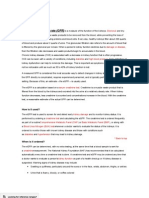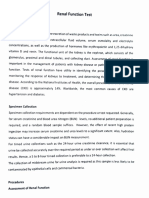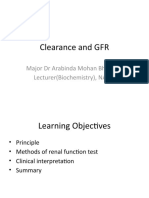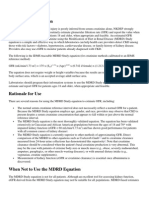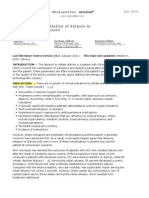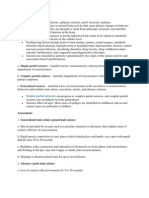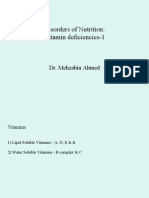0 ratings0% found this document useful (0 votes)
87 viewsDetermining The Glomerular Filtration Rate: Andani Puspita Rani 1315244
This document discusses methods for determining glomerular filtration rate (GFR) to assess kidney function. GFR is considered the best indicator of kidney function and is crucial for diagnosing and staging chronic kidney disease. GFR can be measured directly through clearance tests or estimated using formulas. New formulas have been developed to more accurately estimate GFR, but measurement remains the gold standard. Non-GFR factors like age, muscle mass, and medications can influence biomarkers like creatinine and cystatin C, so their levels must be properly interpreted. Standardizing assays and increasing awareness of non-GFR determinants can improve GFR assessment.
Uploaded by
AndreasJoviantoCopyright
© © All Rights Reserved
Available Formats
Download as PPTX, PDF, TXT or read online on Scribd
0 ratings0% found this document useful (0 votes)
87 viewsDetermining The Glomerular Filtration Rate: Andani Puspita Rani 1315244
This document discusses methods for determining glomerular filtration rate (GFR) to assess kidney function. GFR is considered the best indicator of kidney function and is crucial for diagnosing and staging chronic kidney disease. GFR can be measured directly through clearance tests or estimated using formulas. New formulas have been developed to more accurately estimate GFR, but measurement remains the gold standard. Non-GFR factors like age, muscle mass, and medications can influence biomarkers like creatinine and cystatin C, so their levels must be properly interpreted. Standardizing assays and increasing awareness of non-GFR determinants can improve GFR assessment.
Uploaded by
AndreasJoviantoCopyright
© © All Rights Reserved
Available Formats
Download as PPTX, PDF, TXT or read online on Scribd
You are on page 1/ 15
DETERMINING THE
GLOMERULAR FILTRATION RATE
Review Article
Elke Schaeffner, MD, MSc
Journal of Renal Nutrition,
Vol 27 No 6 (November), 2017
Andani Puspita Rani
1315244
Introduction
• Glomerular Filtration Rate (GFR) is still considered the
best indicator of kidney function worldwide
• Exact assessment of GFR is crucial for several reasons:
GFR determines the stage of chronic kidney disease
(CKD), as the staging system is based on GFR
• This staging system has several clinical implications, such
as drug dosing, the application of potentially nephrotoxic
contrast agents, the timing of renal replacement therapy,
the appropriateness of living organ donation, and also
the labeling of the diagnosis ‘‘CKD,’’ which has insurance
(and therefore financial) and psychological implications
cont..
• During the last 5 to 10 years, different groups
have worked to optimize GFR assessment, which
has led to a variety of publications about GFR
estimation or measurement
• In an endeavor to come as close as possible to
the true GFR, several novel GFR estimation
formulae (eGFR) have been developed
• A huge body of literature also exists for GFR
measuring (mGFR) methods which are supposed
to be closer to the true GFR compared with the
estimated and serve as ‘‘gold standards’’
whenever a new estimation formula is developed
Measuring GFR
• Measuring GFR is regarded as the more precise
method for determining kidney function and is
therefore frequently referred to as ‘‘gold
standard.’’
• This gold standard method principally involves a
clearance method.
• The one that is still most often used in Germany
is the creatinine clearance. In this case, urine is
collected over a certain period of time—usually
24 hours (with 12 hours also being possible)—to
record the urinary creatinine concentration.
• Another, more precise option is the application of an
intravenous exogenous filtration marker, with
subsequent measurement of its plasma clearance
(possibly in combination with the urinary clearance.
• A distinction is made in a 2-compartment model
between a ‘‘fast component’’ and a ‘‘slow
component’’ phase, with the former corresponding to
the ‘‘central’’ distribution of the marker in the blood
and organs and the latter to its distribution in the
peripheral areas (i.e., areas with less blood circulation,
such as muscle or fatty tissue) and the renal
elimination of the contrast medium from the blood
Estimated GFR
• An estimation formula that was only
developed in sick people (e.g., Modification of
Diet in Renal Disease [MDRD] study)
underestimates GFR in healthy people.
• Conversely, a formula that was principally
developed in healthy people would
overestimate GFR in sick people.
Newer Estimation Formulae
Non-GFR Determinants
• Non-GFR determinants are factors that can
influence endogenous biomarkers such as
creatinine or cystatin C independently of GFR
• For this reason, it is important to be aware of
non-GFR determinants, so that GFR results
can be better interpreted in certain clinical
situations
• Scenarios could be a normal creatinine but
elevated cystatin C because of different causes:
– That is, an elderly woman with low muscular mass
who has CKD
– patient being treated with chemotherapy for
lymphoma.
• In the first case, creatinine is dependent on
muscle mass and thus not a suitable marker to
detect reduced kidney function in this particular
patient
• In the second scenario, cystatin C is influenced
(elevated) by the chemotherapy falsely
suggesting impaired kidney function
Standardization of Assays
• Standardization of Assays The standardization
of laboratory assays is extremely important
when endogenous biomarkers such a
creatinine and cystatin C are used.
• Creatinin use an enzymatic method or isotope
dilution mass spectrometry (IDMS traceable)
or Colorimetric Jaffe method
• Cystatin C use nephelometric Siemens assay
corresponded to this standardization
Conclusion
• Kidney function can be determined using either
estimation formulae or measuring methods
• After being the primary filtration marker for decades,
creatinine has now been joined by cystatin C in recent
years
• In this context, physicians should become more aware
of the significance of ‘‘non-GFR determinants’’ for
interpreting GFR values
• Also worth mentioning are the new FAS formulae,
which are being applied as the first formulae for all age
categories, although they are still waiting for external
validation before being used area-wide.
• As a rule, laboratories should only use standardized
assays, even if this reality is still in the distant future.
Thank You
You might also like
- Understanding Chronic Kidney Disease: A guide for the non-specialistFrom EverandUnderstanding Chronic Kidney Disease: A guide for the non-specialist4/5 (3)
- Readers Digest International - March 2017No ratings yetReaders Digest International - March 2017130 pages
- Argumentative Essay: Persuasive Essay:: Animal Testing Animal TestingNo ratings yetArgumentative Essay: Persuasive Essay:: Animal Testing Animal Testing1 page
- Determining The Glomerular Filtration Rate-An Overview: Elke Schaeffner, MD, MSCNo ratings yetDetermining The Glomerular Filtration Rate-An Overview: Elke Schaeffner, MD, MSC6 pages
- The Test Sample: Glomerular Filtration Rate (GFR)No ratings yetThe Test Sample: Glomerular Filtration Rate (GFR)4 pages
- Frequently Asked Questions About: GFR EstimatesNo ratings yetFrequently Asked Questions About: GFR Estimates20 pages
- ASSESSMENT OF GRF NEPHO TEMPLATE ANSWERSNo ratings yetASSESSMENT OF GRF NEPHO TEMPLATE ANSWERS39 pages
- Laboratory Assessment of Kidney Disease 2011No ratings yetLaboratory Assessment of Kidney Disease 201121 pages
- How To Adjust Drug Doses in Chronic Kidney DiseaseNo ratings yetHow To Adjust Drug Doses in Chronic Kidney Disease5 pages
- 12- Renal Function Tests - Urea - Creatinine - GFR-1No ratings yet12- Renal Function Tests - Urea - Creatinine - GFR-123 pages
- Clearance and GFR: Major DR Arabinda Mohan Bhattarai Lecturer (Biochemistry), NAIHSNo ratings yetClearance and GFR: Major DR Arabinda Mohan Bhattarai Lecturer (Biochemistry), NAIHS25 pages
- Estimating Renal Function For Drug Dosing Decisions: Mini-ReviewNo ratings yetEstimating Renal Function For Drug Dosing Decisions: Mini-Review8 pages
- Pertemuan 10 Koreksi Dosis Pada Gangguan Ginjal Dan HatiNo ratings yetPertemuan 10 Koreksi Dosis Pada Gangguan Ginjal Dan Hati60 pages
- Assesment of Glomerular Filtration RateNo ratings yetAssesment of Glomerular Filtration Rate10 pages
- Current Medical Diagnosis and Treatment 2024-941-1007No ratings yetCurrent Medical Diagnosis and Treatment 2024-941-100767 pages
- GFR and Albuminuria Level in Acute and Chronic Kidney DiseaseNo ratings yetGFR and Albuminuria Level in Acute and Chronic Kidney Disease9 pages
- ccpc15 Principles Renal Clearance Acute Kidney Renal Replacement Workbook67% (3)ccpc15 Principles Renal Clearance Acute Kidney Renal Replacement Workbook22 pages
- 1 Evaluación de La Tasa de Filtración GlomerularNo ratings yet1 Evaluación de La Tasa de Filtración Glomerular11 pages
- Assessment of Kidney Function Clinical Indications For Measured GFRNo ratings yetAssessment of Kidney Function Clinical Indications For Measured GFR10 pages
- 2022 NEJM Uses of GFR and Albuminuria LevelNo ratings yet2022 NEJM Uses of GFR and Albuminuria Level9 pages
- Kidney: Biochemical Tests For Assessing Renal Functions100% (1)Kidney: Biochemical Tests For Assessing Renal Functions56 pages
- University of Duhok College of Science Department of Biology Second StageNo ratings yetUniversity of Duhok College of Science Department of Biology Second Stage26 pages
- Complementary and Alternative Medical Lab Testing Part 6: Liver and GallbladderFrom EverandComplementary and Alternative Medical Lab Testing Part 6: Liver and GallbladderNo ratings yet
- Maed The 213 - Advance Home Economics Activity #2 - Reflection Paper # 2No ratings yetMaed The 213 - Advance Home Economics Activity #2 - Reflection Paper # 23 pages
- DR Manish Pagaria - Top Tips On Respiratory Calls - 0 - 0 - 0 PDFNo ratings yetDR Manish Pagaria - Top Tips On Respiratory Calls - 0 - 0 - 0 PDF56 pages
- Operational Challenges of Sewage Treatment Plants in Hilly Cold Climate: A Case Study of Shimla, IndiaNo ratings yetOperational Challenges of Sewage Treatment Plants in Hilly Cold Climate: A Case Study of Shimla, India19 pages
- Unconventional Fixed Partial Denture: A Simple Solution For Aesthetic RehabilitationNo ratings yetUnconventional Fixed Partial Denture: A Simple Solution For Aesthetic Rehabilitation4 pages
- Your Reliable Partner... ... For Quality Products: An ISO 9001 & ISO 22000 Certified Company100% (2)Your Reliable Partner... ... For Quality Products: An ISO 9001 & ISO 22000 Certified Company28 pages
- Clinical Nutrition: A.M. Navarro, M.A. Martinez-Gonzalez, A. Gea, R. Ramallal, M. Ruiz-Canela, E. ToledoNo ratings yetClinical Nutrition: A.M. Navarro, M.A. Martinez-Gonzalez, A. Gea, R. Ramallal, M. Ruiz-Canela, E. Toledo9 pages
- Sport Science and Sports Medicine Framework 2017 v1No ratings yetSport Science and Sports Medicine Framework 2017 v131 pages
- Return To Work Post COVID-19 Illness/ LockdownNo ratings yetReturn To Work Post COVID-19 Illness/ Lockdown20 pages
- Ocular Disease Recognition Using Deep LearningNo ratings yetOcular Disease Recognition Using Deep Learning7 pages
- Formulir DDST II Denver Development ScreNo ratings yetFormulir DDST II Denver Development Scre5 pages
- Testing English Language Reading & WritingNo ratings yetTesting English Language Reading & Writing22 pages
- Understanding Chronic Kidney Disease: A guide for the non-specialistFrom EverandUnderstanding Chronic Kidney Disease: A guide for the non-specialist
- Argumentative Essay: Persuasive Essay:: Animal Testing Animal TestingArgumentative Essay: Persuasive Essay:: Animal Testing Animal Testing
- Determining The Glomerular Filtration Rate-An Overview: Elke Schaeffner, MD, MSCDetermining The Glomerular Filtration Rate-An Overview: Elke Schaeffner, MD, MSC
- How To Adjust Drug Doses in Chronic Kidney DiseaseHow To Adjust Drug Doses in Chronic Kidney Disease
- 12- Renal Function Tests - Urea - Creatinine - GFR-112- Renal Function Tests - Urea - Creatinine - GFR-1
- Clearance and GFR: Major DR Arabinda Mohan Bhattarai Lecturer (Biochemistry), NAIHSClearance and GFR: Major DR Arabinda Mohan Bhattarai Lecturer (Biochemistry), NAIHS
- Estimating Renal Function For Drug Dosing Decisions: Mini-ReviewEstimating Renal Function For Drug Dosing Decisions: Mini-Review
- Pertemuan 10 Koreksi Dosis Pada Gangguan Ginjal Dan HatiPertemuan 10 Koreksi Dosis Pada Gangguan Ginjal Dan Hati
- Current Medical Diagnosis and Treatment 2024-941-1007Current Medical Diagnosis and Treatment 2024-941-1007
- GFR and Albuminuria Level in Acute and Chronic Kidney DiseaseGFR and Albuminuria Level in Acute and Chronic Kidney Disease
- ccpc15 Principles Renal Clearance Acute Kidney Renal Replacement Workbookccpc15 Principles Renal Clearance Acute Kidney Renal Replacement Workbook
- Assessment of Kidney Function Clinical Indications For Measured GFRAssessment of Kidney Function Clinical Indications For Measured GFR
- Kidney: Biochemical Tests For Assessing Renal FunctionsKidney: Biochemical Tests For Assessing Renal Functions
- University of Duhok College of Science Department of Biology Second StageUniversity of Duhok College of Science Department of Biology Second Stage
- Complementary and Alternative Medical Lab Testing Part 6: Liver and GallbladderFrom EverandComplementary and Alternative Medical Lab Testing Part 6: Liver and Gallbladder
- Maed The 213 - Advance Home Economics Activity #2 - Reflection Paper # 2Maed The 213 - Advance Home Economics Activity #2 - Reflection Paper # 2
- DR Manish Pagaria - Top Tips On Respiratory Calls - 0 - 0 - 0 PDFDR Manish Pagaria - Top Tips On Respiratory Calls - 0 - 0 - 0 PDF
- Operational Challenges of Sewage Treatment Plants in Hilly Cold Climate: A Case Study of Shimla, IndiaOperational Challenges of Sewage Treatment Plants in Hilly Cold Climate: A Case Study of Shimla, India
- Unconventional Fixed Partial Denture: A Simple Solution For Aesthetic RehabilitationUnconventional Fixed Partial Denture: A Simple Solution For Aesthetic Rehabilitation
- Your Reliable Partner... ... For Quality Products: An ISO 9001 & ISO 22000 Certified CompanyYour Reliable Partner... ... For Quality Products: An ISO 9001 & ISO 22000 Certified Company
- Clinical Nutrition: A.M. Navarro, M.A. Martinez-Gonzalez, A. Gea, R. Ramallal, M. Ruiz-Canela, E. ToledoClinical Nutrition: A.M. Navarro, M.A. Martinez-Gonzalez, A. Gea, R. Ramallal, M. Ruiz-Canela, E. Toledo
- Sport Science and Sports Medicine Framework 2017 v1Sport Science and Sports Medicine Framework 2017 v1














